egr BMW X5 2003 E53 M54 Engine Workshop Manual
[x] Cancel search | Manufacturer: BMW, Model Year: 2003, Model line: X5, Model: BMW X5 2003 E53Pages: 48, PDF Size: 2.52 MB
Page 5 of 48
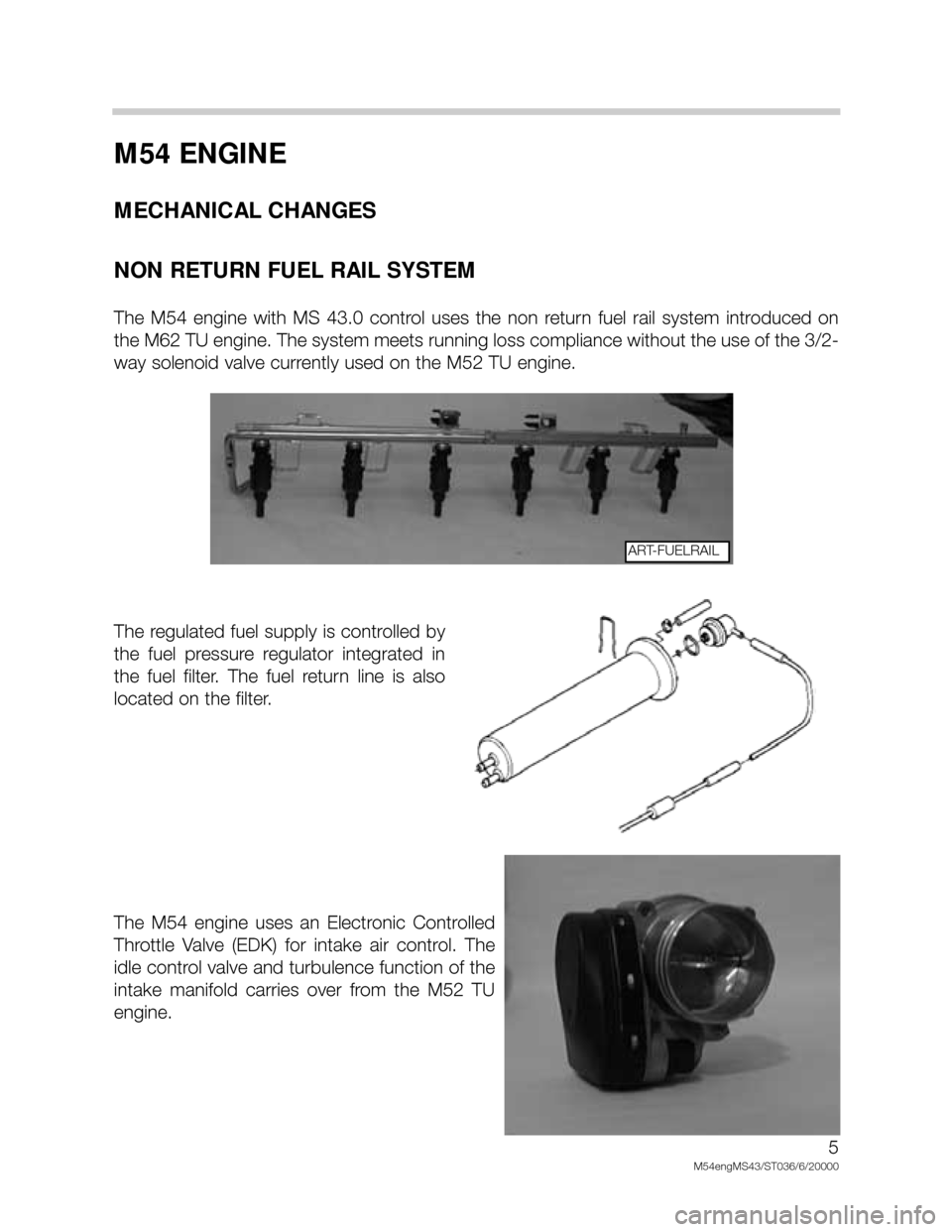
M54 ENGINE
MECHANICAL CHANGES
NON RETURN FUEL RAIL SYSTEM
The M54 engine with MS 43.0 control uses the non return fuel rail system introduced on
the M62 TU engine. The system meets running loss compliance without the use of the 3/2-
way solenoid valve currently used on the M52 TU engine.
The regulated fuel supply is controlled by
the fuel pressure regulator integrated in
the fuel filter. The fuel return line is also
located on the filter.
The M54 engine uses an Electronic Controlled
Throttle Valve (EDK) for intake air control. The
idle control valve and turbulence function of the
intake manifold carries over from the M52 TU
engine.
5
M54engMS43/ST036/6/20000
ART-FUELRAIL
Page 7 of 48
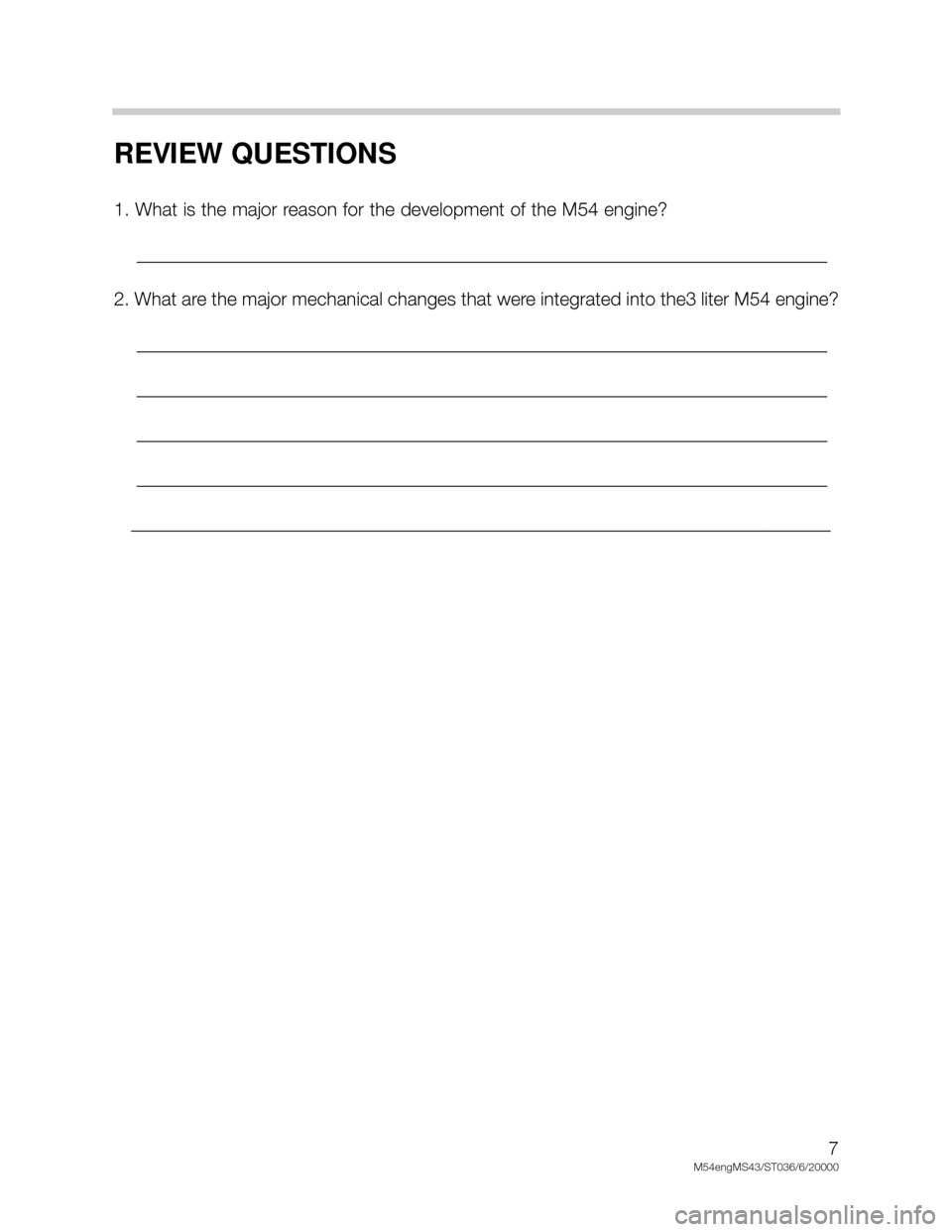
7
M54engMS43/ST036/6/20000
REVIEW QUESTIONS
1. What is the major reason for the development of the M54 engine?
__________________________________________________________________________
2. What are the major mechanical changes that were integrated into the3 liter M54 engine?
__________________________________________________________________________
__________________________________________________________________________
__________________________________________________________________________
__________________________________________________________________________
___________________________________________________________________________
Page 12 of 48
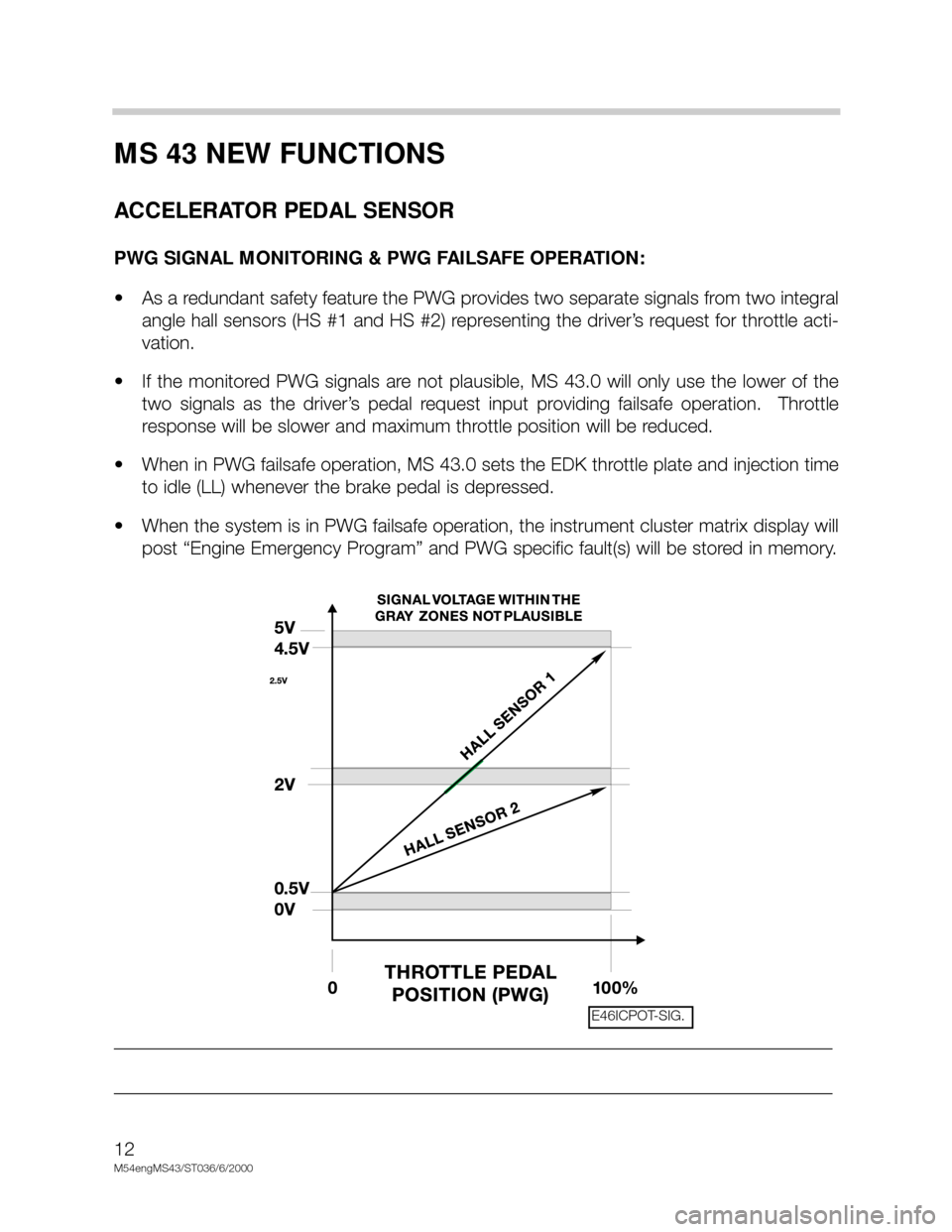
12
M54engMS43/ST036/6/2000
MS 43 NEW FUNCTIONS
ACCELERATOR PEDAL SENSOR
PWG SIGNAL MONITORING & PWG FAILSAFE OPERATION:
• As a redundant safety feature the PWG provides two separate signals from two integral
angle hall sensors (HS #1 and HS #2) representing the driver’s request for throttle acti-
vation.
• If the monitored PWG signals are not plausible, MS 43.0 will only use the lower of the
two signals as the driver’s pedal request input providing failsafe operation. Throttle
response will be slower and maximum throttle position will be reduced.
• When in PWG failsafe operation, MS 43.0 sets the EDK throttle plate and injection time
to idle (LL) whenever the brake pedal is depressed.
• When the system is in PWG failsafe operation, the instrument cluster matrix display will
post “Engine Emergency Program” and PWG specific fault(s) will be stored in memory.
_____________________________________________________________________________
_____________________________________________________________________________
E46ICPOT-SIG.
Page 13 of 48
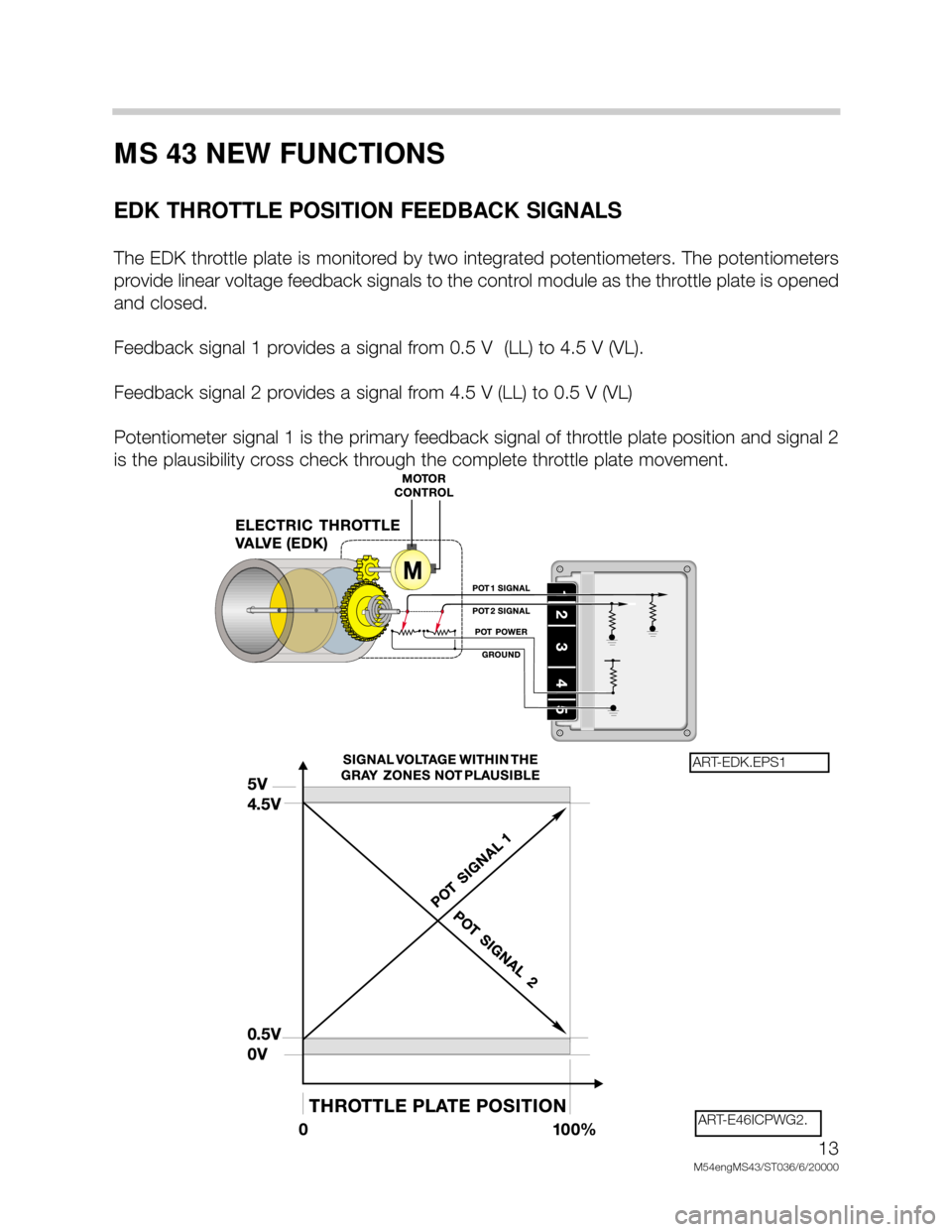
13
M54engMS43/ST036/6/20000
MS 43 NEW FUNCTIONS
EDK THROTTLE POSITION FEEDBACK SIGNALS
The EDK throttle plate is monitored by two integrated potentiometers. The potentiometers
provide linear voltage feedback signals to the control module as the throttle plate is opened
and closed.
Feedback signal 1 provides a signal from 0.5 V (LL) to 4.5 V (VL).
Feedback signal 2 provides a signal from 4.5 V (LL) to 0.5 V (VL)
Potentiometer signal 1 is the primary feedback signal of throttle plate position and signal 2
is the plausibility cross check through the complete throttle plate movement.
ART-EDK.EPS1
ART-E46ICPWG2.
Page 14 of 48

14
M54engMS43/ST036/6/2000
MS 43 NEW FUNCTIONS
EDK THROTTLE POSITION FEEDBACK SIGNALS
EDK FEEDBACK SIGNAL MONITORING & EDK FAILSAFE OPERATION:
• The EDK provides two separate signals from two integral potentiometers (Pot 1 and Pot
2) representing the exact position of the throttle plate.
• EDK Pot 1 provides the primary throttle plate position feedback. As a redundant safe-
ty feature, Pot 2 is continuously cross checked with Pot 1 for signal plausibility.
• If plausibility errors are detected between Pot 1 and Pot 2, MS 43.0 will calculate the
inducted engine air mass (from HFM signal) and only utilize the potentiometer signal that
closely matches the detected intake air mass.
- The MS 43.0 uses the air mass signalling as a “virtual potentiometer” (pot 3) for a
comparative source to provide failsafe operation.
- If MS 43.0 cannot calculate a plausible conclusion from the monitored pots (1 or 2
and virtual 3) the EDK motor is switched off and fuel injection cut out is activated
(no failsafe operation possible).
• The EDK is continuously monitored during all phases of engine operation. It is also
briefly activated when KL 15 is initially switched on as a “pre-flight check” to verify it’s
mechanical integrity (no binding, appropriate return spring tension, etc). This is accom-
plished by monitoring both the motor control amperage and the reaction speed of the
EDK feedback potentiometers. If faults are detected the EDK motor is switched off and
fuel injection cut off is activated (no failsafe operation possible). The engine does how-
ever continue to run extremely rough at idle speed.
• When a replacement EDK is installed, the MS 43.0 adapts to the new component
(required amperage draw for motor control, feedback pot tolerance differences, etc).
This occurs immediately after the next cycle of KL 15 for approximately 30 seconds.
During this period of adaptation, the maximum opening of the throttle plate is 25%.
_____________________________________________________________________________
_____________________________________________________________________________
_____________________________________________________________________________
_____________________________________________________________________________
Page 19 of 48
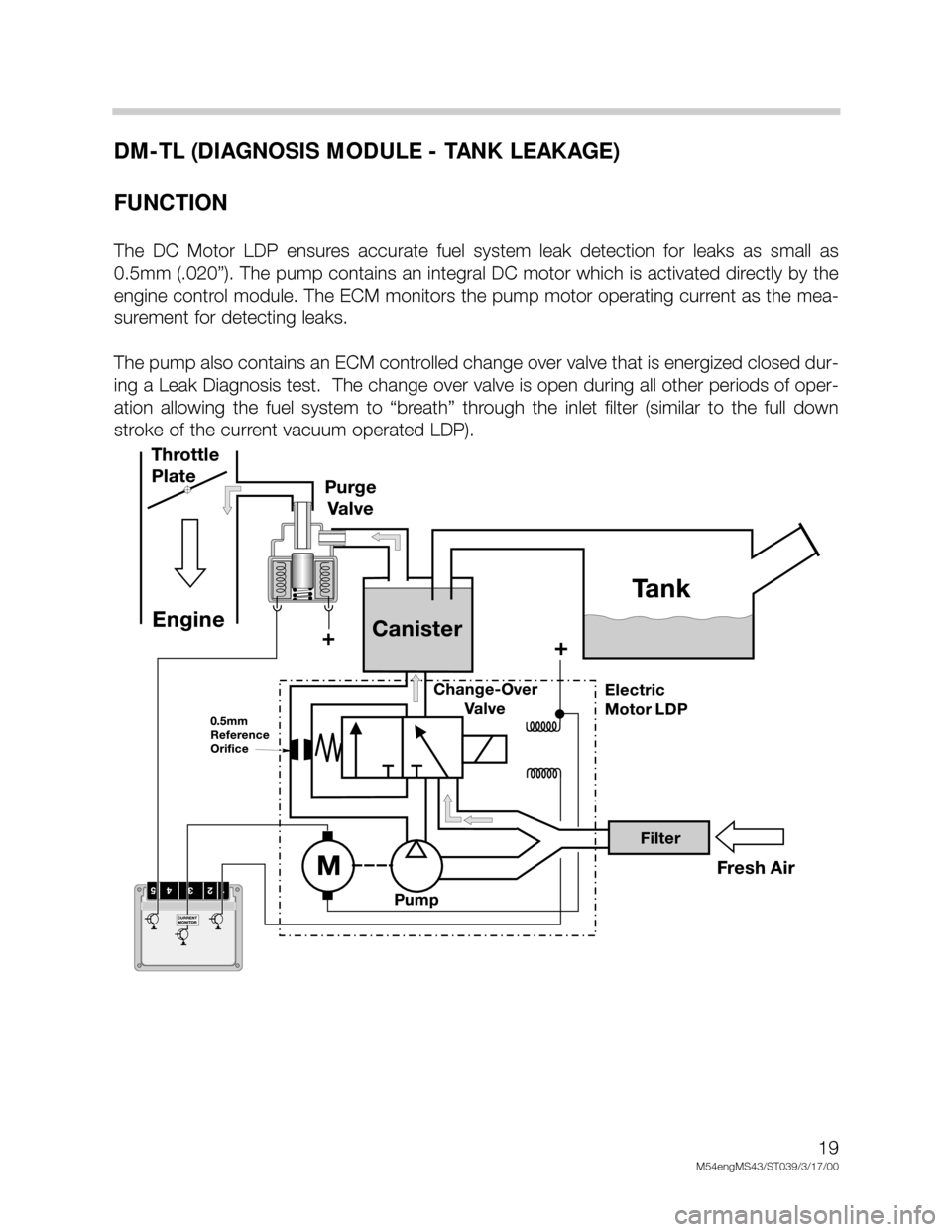
19
M54engMS43/ST039/3/17/00
DM-TL (DIAGNOSIS MODULE - TANK LEAKAGE)
FUNCTION
The DC Motor LDP ensures accurate fuel system leak detection for leaks as small as
0.5mm (.020”). The pump contains an integral DC motor which is activated directly by the
engine control module. The ECM monitors the pump motor operating current as the mea-
surement for detecting leaks.
The pump also contains an ECM controlled change over valve that is energized closed dur-
ing a Leak Diagnosis test. The change over valve is open during all other periods of oper-
ation allowing the fuel system to “breath” through the inlet filter (similar to the full down
stroke of the current vacuum operated LDP).
Page 24 of 48
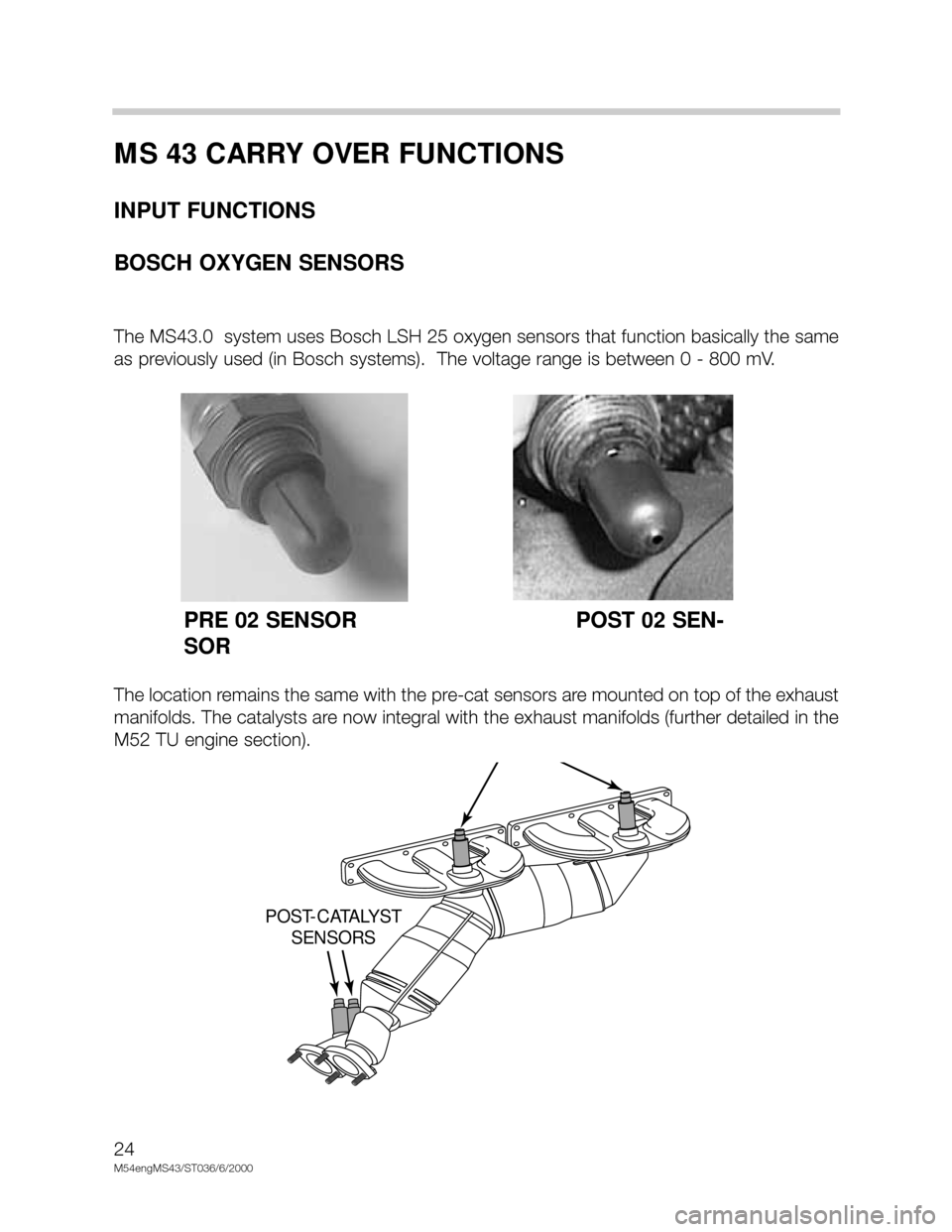
24
M54engMS43/ST036/6/2000
MS 43 CARRY OVER FUNCTIONS
INPUT FUNCTIONS
BOSCH OXYGEN SENSORS
The MS43.0 system uses Bosch LSH 25 oxygen sensors that function basically the same
as previously used (in Bosch systems). The voltage range is between 0 - 800 mV.
The location remains the same with the pre-cat sensors are mounted on top of the exhaust
manifolds. The catalysts are now integral with the exhaust manifolds (further detailed in the
M52 TU engine section).
PRE 02 SENSOR POST 02 SEN-
SOR
POST-CATALYST
SENSORS
Page 32 of 48
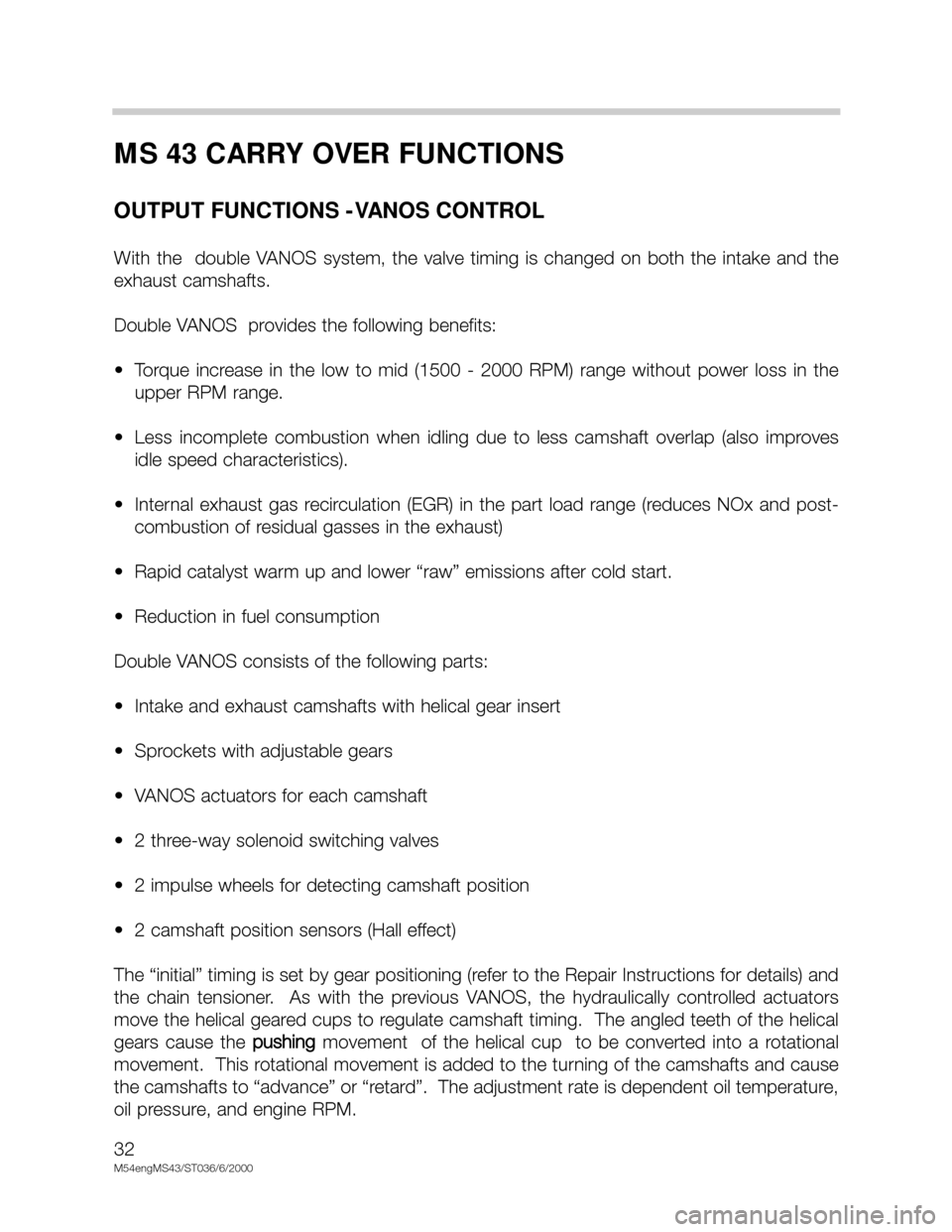
32
M54engMS43/ST036/6/2000
MS 43 CARRY OVER FUNCTIONS
OUTPUT FUNCTIONS -VANOS CONTROL
With the double VANOS system, the valve timing is changed on both the intake and the
exhaust camshafts.
Double VANOS provides the following benefits:
• Torque increase in the low to mid (1500 - 2000 RPM) range without power loss in the
upper RPM range.
• Less incomplete combustion when idling due to less camshaft overlap (also improves
idle speed characteristics).
• Internal exhaust gas recirculation (EGR) in the part load range (reduces NOx and post-
combustion of residual gasses in the exhaust)
• Rapid catalyst warm up and lower “raw” emissions after cold start.
• Reduction in fuel consumption
Double VANOS consists of the following parts:
• Intake and exhaust camshafts with helical gear insert
• Sprockets with adjustable gears
• VANOS actuators for each camshaft
• 2 three-way solenoid switching valves
• 2 impulse wheels for detecting camshaft position
• 2 camshaft position sensors (Hall effect)
The “initial” timing is set by gear positioning (refer to the Repair Instructions for details) and
the chain tensioner. As with the previous VANOS, the hydraulically controlled actuators
move the helical geared cups to regulate camshaft timing. The angled teeth of the helical
gears cause the pushing
movement of the helical cup to be converted into a rotational
movement. This rotational movement is added to the turning of the camshafts and cause
the camshafts to “advance” or “retard”. The adjustment rate is dependent oil temperature,
oil pressure, and engine RPM.
Page 35 of 48
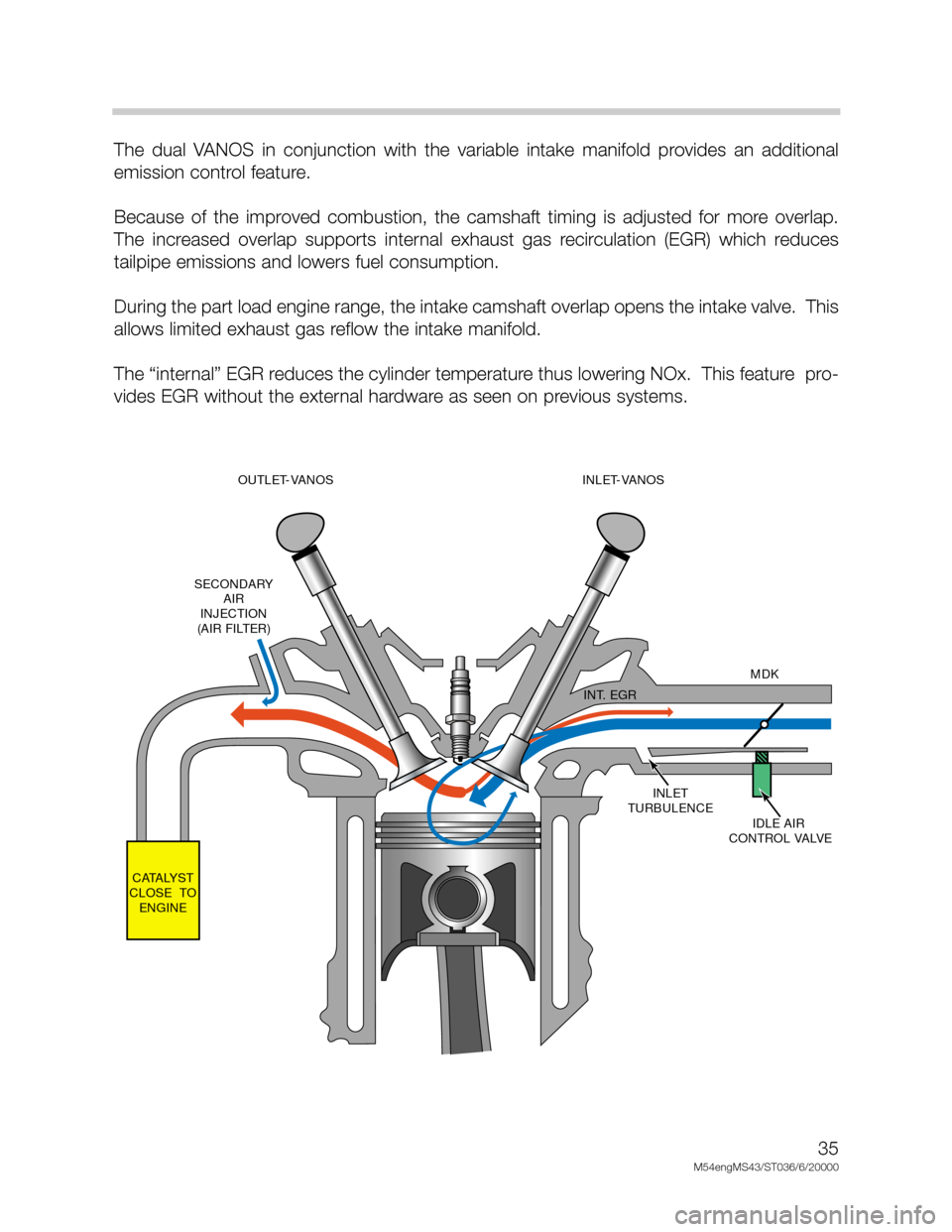
35
M54engMS43/ST036/6/20000
The dual VANOS in conjunction with the variable intake manifold provides an additional
emission control feature.
Because of the improved combustion, the camshaft timing is adjusted for more overlap.
The increased overlap supports internal exhaust gas recirculation (EGR) which reduces
tailpipe emissions and lowers fuel consumption.
During the part load engine range, the intake camshaft overlap opens the intake valve. This
allows limited exhaust gas reflow the intake manifold.
The “internal” EGR reduces the cylinder temperature thus lowering NOx. This feature pro-
vides EGR without the external hardware as seen on previous systems.
INLET
TURBULENCE
IDLE AIR
CONTROL VALVEMDK
INT. EGR
CATALYST
CLOSE TO
ENGINESECONDARY
AIR
INJECTION
(AIR FILTER)OUTLET-VANOS
(228/80-105)INLET-VANOS
(228/80-120)
Page 40 of 48
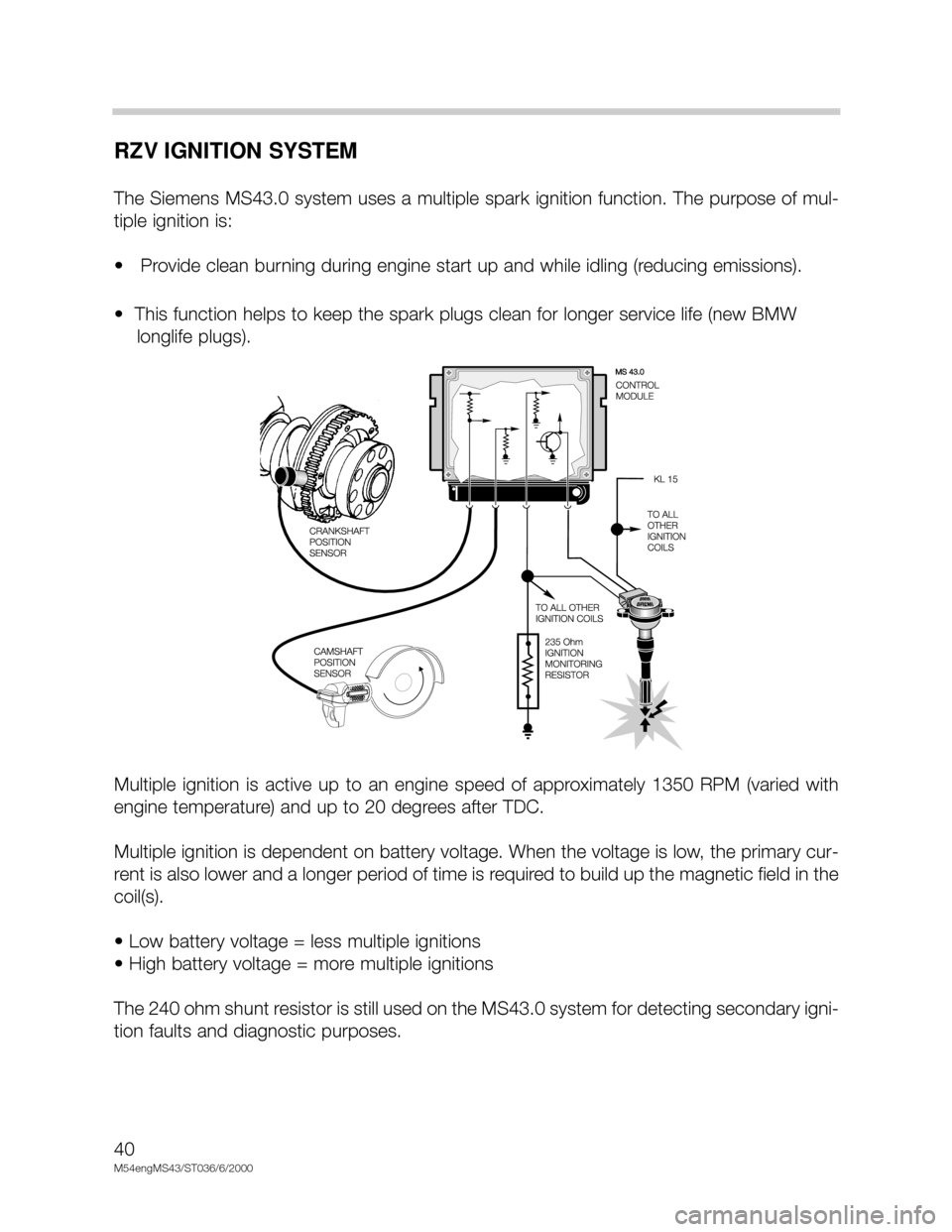
40
M54engMS43/ST036/6/2000
RZV IGNITION SYSTEM
The Siemens MS43.0 system uses a multiple spark ignition function. The purpose of mul-
tiple ignition is:
• Provide clean burning during engine start up and while idling (reducing emissions).
• This function helps to keep the spark plugs clean for longer service life (new BMW
longlife plugs).
Multiple ignition is active up to an engine speed of approximately 1350 RPM (varied with
engine temperature) and up to 20 degrees after TDC.
Multiple ignition is dependent on battery voltage. When the voltage is low, the primary cur-
rent is also lower and a longer period of time is required to build up the magnetic field in the
coil(s).
• Low battery voltage = less multiple ignitions
• High battery voltage = more multiple ignitions
The 240 ohm shunt resistor is still used on the MS43.0 system for detecting secondary igni-
tion faults and diagnostic purposes.
MS 43.0